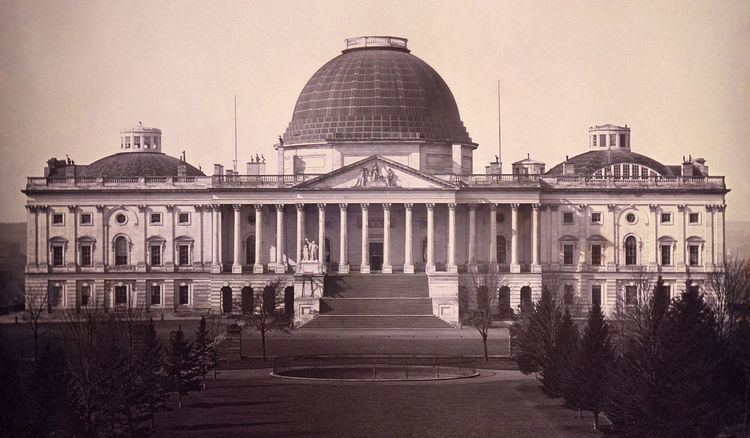The Twenty-ninth United States Congress was a meeting of the legislative branch of the United States federal government, consisting of the United States Senate and the United States House of Representatives. It met in Washington, D.C. from March 4, 1845 to March 4, 1847, during the first two years of the administration of James Polk's presidency. The apportionment of seats in the House of Representatives was based on the Sixth Census of the United States in 1840. Both chambers had a Democratic majority.
March 4, 1845: James K. Polk became President of the United StatesOctober 10, 1845: The Naval School (later renamed the United States Naval Academy) opened in Annapolis, MarylandDecember 2, 1845: President Polk announced to Congress that the Monroe Doctrine should be strictly enforced and that the United States should aggressively expand into the West.April 25, 1846: Open conflict over border disputes of Texas's boundaries began the Mexican-American WarMay 13, 1846: Mexican-American War declared, ch. 16, 9 Stat. 9July 9, 1846: District of Columbia retrocession, ch. 35, 9 Stat. 35July 30, 1846: Walker tariff, ch. 74, 9 Stat. 42June 15, 1846: Oregon Treaty established the 49th parallel as the border between the United States and Canada, from the Rocky Mountains to the Strait of Juan de FucaJanuary 13, 1847: Treaty of Cahuenga ended the fighting in the Mexican-American War in California (not a formal treaty between nations but an informal agreement between rival military forces)December 29, 1845: Texas admitted as the 28th stateDecember 28, 1846: Iowa admitted as the 29th stateDuring this congress, two Senate seats were added for each of the new states of Texas and Iowa.
During this congress, two House seats were added for each of the new states of Texas and Iowa.
President: George M. Dallas (D)President pro tempore: Willie P. Mangum (W), until March 4, 1845Ambrose Hundley Sevier (D), only on December 27, 1845David R. Atchison (D), from August 8, 1846Speaker: John W. Davis (D)This list is arranged by chamber, then by state. Senators are listed in order of seniority, and Representatives are listed by district.
Senators were elected by the state legislatures every two years, with one-third beginning new six-year terms with each Congress. Preceding the names in the list below are Senate class numbers, which indicate the cycle of their election. In this Congress, Class 1 meant their term began with this Congress, requiring reelection in 1850; Class 2 meant their term ended with this Congress, requiring reelection in 1846; and Class 3 meant their term began in the last Congress, requiring reelection in 1848.
Skip to House of Representatives, belowThe names of members of the House of Representatives are preceded by their district numbers.
The count below reflects changes from the beginning of the first session of this Congress.
replacements: 8Democrats (D): no net changeWhigs (W): no net changedeaths: 3resignations: 6interim appointments: 1seats of newly admitted states: 4Total seats with changes: 14replacements: 12Democrats (D): 1 seat net gainWhigs (W): 1 seat net lossdeaths: 5resignations: 6contested election: 1seats of newly admitted states: 4Total seats with changes: 17Lists of committees and their party leaders.
AgricultureAudit and Control the Contingent Expenses of the SenateCharges of Corruption Contained in the Daily Times (Select)ClaimsCommerceDistributing Public Revenue Among the States (Select)District of ColumbiaFinanceForeign RelationsFrench Spoilations (Select)Indian AffairsInternational Copyright Law (Select)JudiciaryManufacturesMemorial on W.T.G. Morton (Select)Memphis Convention (Select)Military AffairsMilitiaNaval AffairsOrdnance and War Ships (Select)Patents and the Patent OfficePensionsPost Office and Post RoadsPrintingPrivate Land ClaimsPublic Buildings and GroundsPublic LandsRetrenchmentRevolutionary ClaimsRoads and CanalsTariff Regulation (Select)TerritoriesSmithsonian Institution (Select)WholeAccountsAgricultureClaimsCommerceDistrict of ColumbiaElectionsEngravingExpenditures in the Navy DepartmentExpenditures in the Post Office DepartmentExpenditures in the State DepartmentExpenditures in the Treasury DepartmentExpenditures in the War DepartmentExpenditures on Public BuildingsForeign AffairsIndian AffairsInvalid PensionsManufacturesMileageMilitary AffairsMilitiaNaval AffairsPatentsPost Office and Post RoadsPublic Buildings and GroundsPublic ExpendituresPublic LandsRevisal and Unfinished BusinessRevolutionary ClaimsRoads and CanalsRules (Select)Standards of Official ConductTerritoriesWays and MeansWholeEnrolled BillsSmithsonian BequestLibrarian of Congress: John Silva MeehanChaplain:Septimus Tustin (Presbyterian)Henry Slicer (Methodist), elected December 16, 1846Secretary: Asbury DickensSergeant at Arms:Edward Dyer, died September 8, 1845Robert Beale, elected December 9, 1845Chaplain:William H. Milburn (Methodist)William T.S. Sprole (Presbyterian), elected December 7, 1846Clerk: Benjamin B. FrenchDoorkeeper: Cornelius C. WhitneyPostmaster: John M. JohnsonSergeant at Arms: Newton Lane 
